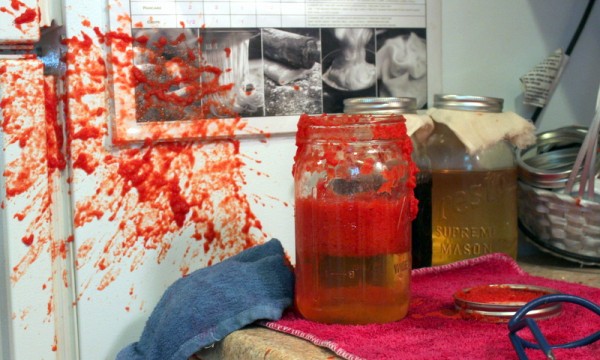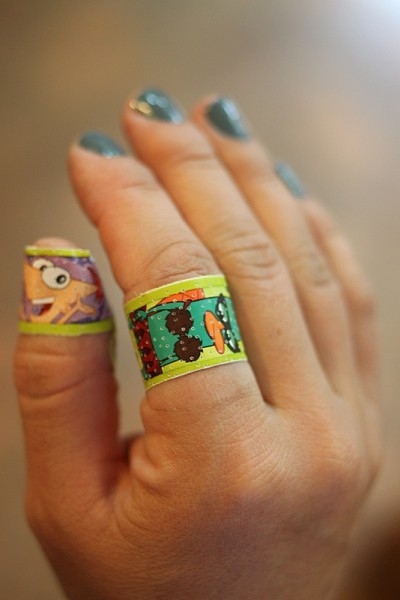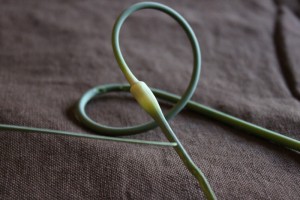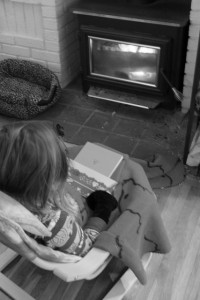 My students at canning classes frequently express concern about botulism. I ease their fears about that rare occurrence by assuring them they should worry about burns instead. Hanging around boiling water, hot jars, and simmering sauces is a recipe for a brush with hot stuff, one I experienced today.
My students at canning classes frequently express concern about botulism. I ease their fears about that rare occurrence by assuring them they should worry about burns instead. Hanging around boiling water, hot jars, and simmering sauces is a recipe for a brush with hot stuff, one I experienced today.
My friend Kate of Kate On The Way and I were canning sauced tomatoes in quarts. During the water bath phase, one of the lids loosened and tomato sauce seeped into the boil. No problem, we kept the other jars in there to finish processing.
Kate removed a jar after the finished time. As she went to tighten the ring a bit (a necessary step for Tattler lids), the lid flew off, creating an explosion of tomato. We both were covered in the spray of boiling sugary puree.
We ran for cool water and eventually made our way outside to harvest, chew, and apply plantain poultice. Our left arms have a series of first and second degree* burns with Kate suffering more than me.
Alex was kind enough to pull the remaining jars from the canner after they cooled a little. By then, three of the remaining jars had also lost their lids, the contents mingling with the water bath.
Learning From A Canning Accident
Since neither of us were hurt badly, we moved pretty quickly into the "how did this happen?" phase. Kate and I have each canned hundreds of jars of food before, if not thousands.
We referenced a canning book and filled the jars to the right head space. We heated the canning bath to a simmer so the jars weren't rattling in a raging boil. We used a proper canner with a rack on the bottom. We have done all of these things many times.
We concluded that the lids must have been the issue. Although they were tightened according to directions, and Kate and I both have used them before, the Tattler process failed this time. Will we ever use Tattlers again? Kate says yes, I'm less sure.
Additionally, I experienced why it isn't a good idea to hover when someone else is pulling jars out of the water bath. I can't remember exactly why I was near - I might have been getting ready to grab something out of the fridge - but I shouldn't have been so close. While the Tattlers might be responsible in this case, glass failures and drops can also occur when jars are moved from the water bath to the cooling place. Someone standing nearby can be in the line of fire.
Finally, we were reminded that even experienced canners must remain vigilant to the risks at hand. We feel fortunate that the liquid exploded onto our bodies and not our faces, and that no pets or children were caught in the splatter. We lost some home-grown goodness and in a little bit of pain, but ultimately realize this could have been much worse.
We'll continue to put up food using water bath and pressure canning, with these lessons learned:
- Use caution if you use Tattler lids with liquidy sauces
- Stand back when removing hot jars from the hot water bath
- Keep children and pets at a distance when canning
- Have a plan in place for treating burns
- *Identify some plantain in your yard. By all accounts, we should have blistered burns but thanks to plantain we don't. Kate details a little more about using plantain to heal.
What's your worst canning disaster? What did you learn from it?









 We aim to make most things from scratch. To that end, we spend plenty of time cooking. Because we love to eat, cooking does not feel like a chore. Still, I was curious exactly how much time we spend in the kitchen.
Like last year's
We aim to make most things from scratch. To that end, we spend plenty of time cooking. Because we love to eat, cooking does not feel like a chore. Still, I was curious exactly how much time we spend in the kitchen.
Like last year's